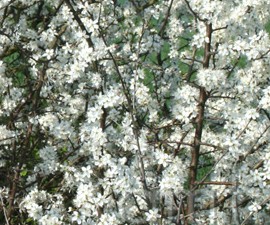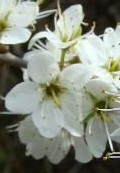 Blackthorn is a suckering deciduous shrub or small tree native to Europe, western Asian, and areas of northwest Africa where it grows in hedgerows, thickets, scrubland, and woodland edges. It is a member of the rose family (Rosaceae) and in the same genus as cherry, almond, and plum. The dense branches have dark bark and spines about three inches long. The oval leaves have serrated margins and are ¾ to 1 ¾ inches long by ½ to ¾ inches wide. The creamy white flowers with five petals appear slightly before the leaves in early spring and are about ½ inch across. They are followed in the fall by half inch wide blue black fruits enhanced with a whitish bloom that are called sloe and used to flavor alcoholic beverages. The plants are important to wildlife by providing food and cover for birds and insects. The genus name, Prunus, comes from the Greek word προύνη meaning plum, a prominent member of this genus. The specific epithet, spinosa, is from the Latin word spina, meaning thorn.
Blackthorn is a suckering deciduous shrub or small tree native to Europe, western Asian, and areas of northwest Africa where it grows in hedgerows, thickets, scrubland, and woodland edges. It is a member of the rose family (Rosaceae) and in the same genus as cherry, almond, and plum. The dense branches have dark bark and spines about three inches long. The oval leaves have serrated margins and are ¾ to 1 ¾ inches long by ½ to ¾ inches wide. The creamy white flowers with five petals appear slightly before the leaves in early spring and are about ½ inch across. They are followed in the fall by half inch wide blue black fruits enhanced with a whitish bloom that are called sloe and used to flavor alcoholic beverages. The plants are important to wildlife by providing food and cover for birds and insects. The genus name, Prunus, comes from the Greek word προύνη meaning plum, a prominent member of this genus. The specific epithet, spinosa, is from the Latin word spina, meaning thorn.
 Type: Deciduous, suckering shrub or small tree
Type: Deciduous, suckering shrub or small tree
Outstanding Feature: White flowers, black berries
Form: Rounded mound
Growth Rate: Medium
Bloom: Cfeamy white five petaled flowers in early spring
Size: 20’ H x 20’ W
Light: Full sun to partial shade
 Soil: Average, moist, well-drained
Soil: Average, moist, well-drained
Care: Low maintenance
Hardiness: Zones 5-9
Pests and Diseases: Susceptible to aphids, caterpillars, silver leaf, blossom wilt
Propagation: Seed, semi-ripe cuttings, suckers (easiest)
Outstanding Selections:
‘Plena’ (pure white double flowers)
‘Purpurea’ (6 ½’ tall, purple leaves, white flowers)